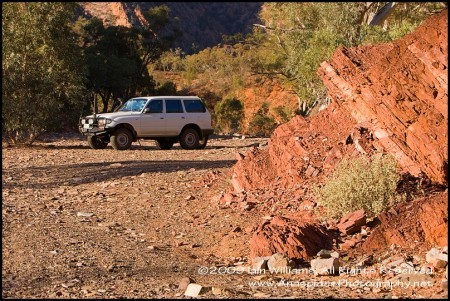 An early wake up at 530 AM and a short scramble to ensure I was in place for the early morning light. I want to capture the yellow foots as they made their way back up the slope to their daytime hides.
An early wake up at 530 AM and a short scramble to ensure I was in place for the early morning light. I want to capture the yellow foots as they made their way back up the slope to their daytime hides.
I'm particularly careful when photographing wild animals that I do not approach too close, which can cause undue stress and alarm. The desert environment is boom and bust - and energy used unwisely can cause potential shortcomings later on. Wet conditions are boom times and all wildlife profits, however, as soon as drought kicks in, only the strongest and most hardy survive.
The days here are quite warm with temperatures in the early 90s (30C). The wallabies hide from the harsh conditions in their rock shelters as photographers hide in their vehicle. The time between shoots (9AM and 3PM) I clean and service equipment, make meals, sleep, read, and reconnoiter new locations.
My base camp on this trip is nowhere fancy - in fact it isn't really a nice camping place at all; it was selected for its proximity to the talus slopes. It's along a dry creek bed and I parked alongside some river gums. Note I said alongside and not underneath; camping beneath river gums is foolhardy, as changes in temperature can cause tree limbs to fall. Several campers have been killed by falling tree branches in the past!
The biggest hassle I have encountered on this trip is photographing in extreme dusty conditions. I mean there is dust on everything and inside everything - and my vehicle is air conditioned and relatively well sealed! The dust has been made worse by a continual 5-10 knot wind which continually blows. At times during the day, the vehicle is buffeted as the wing gusts to 20 knots. Thank goodness it stops in the evening. Keeping digital camera sensors clean is a nightmare and I try to not change lenses if possible, instead relying on the use of 3 bodies with different focal lengths - more to carry in the field, but less work cleaning and dust spotting images during post processing.
 Despite there being a multitude of camp sites available, every site captures the wind at some stage during the day, and the dust is impartial - it goes everywhere. The dry rivercourse above is where I spent my entire time when shooting this assignment.
Despite there being a multitude of camp sites available, every site captures the wind at some stage during the day, and the dust is impartial - it goes everywhere. The dry rivercourse above is where I spent my entire time when shooting this assignment.
Photographing this afternoon appeared to a waste of time, until I observed a juvenile and mother amongst the cassarina trees. I also noted two sub adults mating higher on the slope, however, obtaining a clean shot of "mating behaviour" was impossible. The two wallabies in the trees were feeding on flowers located amongst the rocks. Due to the high amount of dust in the air clear images were not possible so I took solace in watching instead!
That night I listened to bats swooping low overhead feeding upon insects. I also heard several wallabies scurrying across the rocky creek bed in search of better food on the opposite bank.